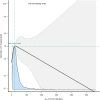The use of high-sensitivity cardiac troponin T and creatinine kinase-MB as a prognostic markers in patients with acute myocardial infarction and chronic kidney disease
- PMID: 37278148
- PMCID: PMC10246482
- DOI: 10.1080/0886022X.2023.2220420
The use of high-sensitivity cardiac troponin T and creatinine kinase-MB as a prognostic markers in patients with acute myocardial infarction and chronic kidney disease
Abstract
Background: High-sensitivity cardiac troponin T (hs-cTnT) and creatine kinase (CK)-MB are the most commonly used biomarkers for the diagnosis and prognosis of acute myocardial infarction (AMI). Chronic kidney disease (CKD) often leads to elevated hs-cTnT levels in non-AMI patients. However, studies comparing the prognostic value of both hs-cTnT and CK-MB in patients with AMI and CKD are lacking.Methods: We conducted a retrospective study on AMI patients diagnosed between January 2015 and October 2020. Patients were categorized based on renal function as normal or CKD. Peak hs-cTnT and CK-MB levels during hospitalization were collected, and their diagnostic value was evaluated using receiver operating characteristic (ROC) curves. The impact on in-hospital mortality was analyzed using multivariate logistic regression. The relationship between the hs-cTnT/CK-MB ratio and in-hospital death was examined using a restricted cubic spline (RCS) curve.Results: The study included 5022 AMI patients, of whom 797 (15.9%) had CKD. The AUCs of Hs-cTnT and CK-MB were higher in the CKD group [0.842 (95% CI: 0.789-0.894) and 0.821 (95% CI: 0.760-0.882)] than in the normal renal function group [0.695 (95% CI: 0.604-0.790) and 0.708 (95% CI: 0.624-0.793)]. After full adjustment for all risk factors, hs-cTnT (OR, 2.82; 95% CI, 1.03-9.86; p = 0.038) and CK-MB (OR, 4.91; 95% CI, 1.54-14.68; p = 0.007) above the cutoff values were independent predictors of in-hospital mortality in patients with CKD. However, in patients with normal renal function, only CK-MB above the cutoff (OR, 2.45; 95% CI, 1.02-8.24; p = 0.046) was a predictor of in-hospital mortality, whereas hs-cTnT was not. There was an inverted V-shaped relationship between the hs-cTnT/CK-MB ratio and in-hospital mortality, with an inflection point of 19.61. The ratio within the second quartile (9.63-19.6) was an independent predictor of in-hospital mortality in patients with CKD (OR 5.3, 95% CI 1.66-16.86, p = 0.005).Conclusions: Hs-cTnT independently predicted in-hospital mortality in AMI patients with CKD, whereas its predictive value was not observed in patients with normal renal function. CK-MB was an independent predictor of in-hospital mortality regardless of renal function. Moreover, the hs-cTnT/CK-MB ratio may aid in risk stratification of AMI patients with CKD.
Keywords: High-sensitivity cardiac troponin T; acute myocardial infarction; chronic kidney disease; creatine kinase (CK)-MB; prognosis.
Conflict of interest statement
No potential conflict of interest was reported by the author(s).
Figures




References
-
- Reed GW, Rossi JE, Cannon CP.. Acute myocardial infarction. Lancet. 2017;389(10065):1–10. - PubMed
-
- Smilowitz NR, Gupta N, Guo Y, et al. . Management and outcomes of acute myocardial infarction in patients with chronic kidney disease. Int J Cardiol. 2017;227:1–7. - PubMed
-
- Bagai A, Schulte PJ, Granger CB, et al. . Prognostic implications of creatine kinase-MB measurements in ST-segment elevation myocardial infarction patients treated with primary percutaneous coronary intervention. Am Heart J. 2014;168(4):503–511.e502. - PubMed
MeSH terms
Substances
LinkOut - more resources
Full Text Sources
Medical
Research Materials
Miscellaneous
